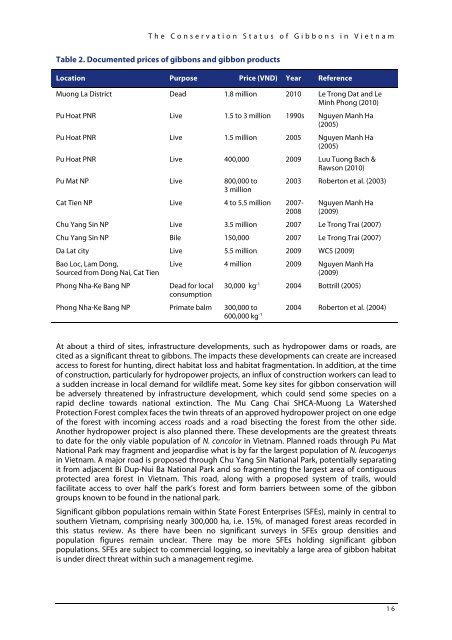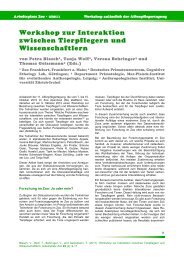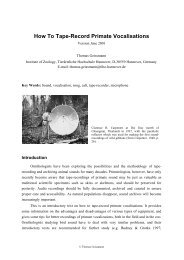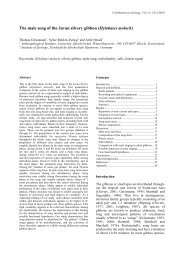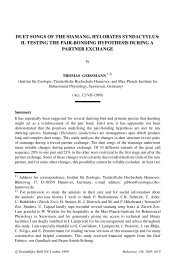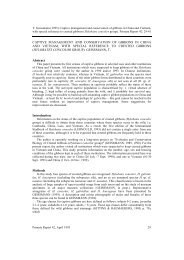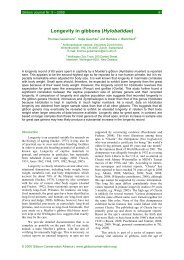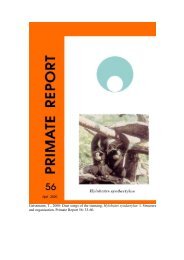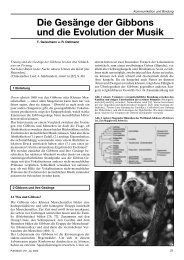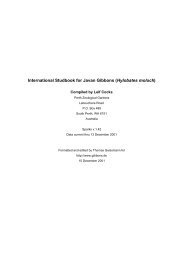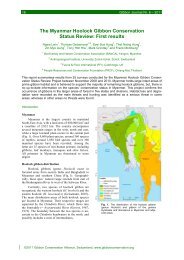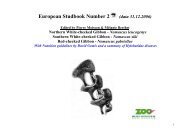<strong>The</strong> <strong>Conservation</strong> <strong>Status</strong> <strong>of</strong> <strong><strong>Gibbon</strong>s</strong> <strong>in</strong> <strong>Vietnam</strong>Table 2. Documented prices <strong>of</strong> gibbons and gibbon productsLocation Purpose Price (VND) Year ReferenceMuong La District Dead 1.8 million 2010 Le Trong Dat and LeM<strong>in</strong>h Phong (2010)Pu Hoat PNR Live 1.5 to 3 million 1990s Nguyen Manh Ha(2005)Pu Hoat PNR Live 1.5 million 2005 Nguyen Manh Ha(2005)Pu Hoat PNR Live 400,000 2009 Luu Tuong Bach &Rawson (2010)Pu Mat NP Live 800,000 to3 million2003 Roberton et al. (2003)Cat Tien NP Live 4 to 5.5 million 2007-2008Nguyen Manh Ha(2009)Chu Yang S<strong>in</strong> NP Live 3.5 million 2007 Le Trong Trai (2007)Chu Yang S<strong>in</strong> NP Bile 150,000 2007 Le Trong Trai (2007)Da Lat city Live 5.5 million 2009 WCS (2009)Bao Loc, Lam Dong,Sourced from Dong Nai, Cat TienPhong Nha-Ke Bang NPPhong Nha-Ke Bang NP Primate balm 300,000 to600,000 kg -1Live 4 million 2009 Nguyen Manh Ha(2009)Dead for local 30,000 kg -1 2004 Bottrill (2005)consumption2004 Roberton et al. (2004)At about a third <strong>of</strong> sites, <strong>in</strong>frastructure developments, such as hydropower dams or roads, arecited as a significant threat to gibbons. <strong>The</strong> impacts these developments can create are <strong>in</strong>creasedaccess to forest for hunt<strong>in</strong>g, direct habitat loss and habitat fragmentation. In addition, at the time<strong>of</strong> construction, particularly for hydropower projects, an <strong>in</strong>flux <strong>of</strong> construction workers can lead toa sudden <strong>in</strong>crease <strong>in</strong> local demand for wildlife meat. Some key sites for gibbon conservation willbe adversely threatened by <strong>in</strong>frastructure development, which could send some species on arapid decl<strong>in</strong>e towards national ext<strong>in</strong>ction. <strong>The</strong> Mu Cang Chai SHCA-Muong La WatershedProtection Forest complex faces the tw<strong>in</strong> threats <strong>of</strong> an approved hydropower project on one edge<strong>of</strong> the forest with <strong>in</strong>com<strong>in</strong>g access roads and a road bisect<strong>in</strong>g the forest from the other side.Another hydropower project is also planned there. <strong>The</strong>se developments are the greatest threatsto date for the only viable population <strong>of</strong> N. concolor <strong>in</strong> <strong>Vietnam</strong>. Planned roads through Pu MatNational Park may fragment and jeopardise what is by far the largest population <strong>of</strong> N. leucogenys<strong>in</strong> <strong>Vietnam</strong>. A major road is proposed through Chu Yang S<strong>in</strong> National Park, potentially separat<strong>in</strong>git from adjacent Bi Dup-Nui Ba National Park and so fragment<strong>in</strong>g the largest area <strong>of</strong> contiguousprotected area forest <strong>in</strong> <strong>Vietnam</strong>. This road, along with a proposed system <strong>of</strong> trails, wouldfacilitate access to over half the park’s forest and form barriers between some <strong>of</strong> the gibbongroups known to be found <strong>in</strong> the national park.Significant gibbon populations rema<strong>in</strong> with<strong>in</strong> State Forest Enterprises (SFEs), ma<strong>in</strong>ly <strong>in</strong> central tosouthern <strong>Vietnam</strong>, compris<strong>in</strong>g nearly 300,000 ha, i.e. 15%, <strong>of</strong> managed forest areas recorded <strong>in</strong>this status review. As there have been no significant surveys <strong>in</strong> SFEs group densities andpopulation figures rema<strong>in</strong> unclear. <strong>The</strong>re may be more SFEs hold<strong>in</strong>g significant gibbonpopulations. SFEs are subject to commercial logg<strong>in</strong>g, so <strong>in</strong>evitably a large area <strong>of</strong> gibbon habitatis under direct threat with<strong>in</strong> such a management regime.16
<strong>The</strong> <strong>Conservation</strong> <strong>Status</strong> <strong>of</strong> <strong><strong>Gibbon</strong>s</strong> <strong>in</strong> <strong>Vietnam</strong>2.4.3 Small and Fragmented PopulationsDespite the best conservation efforts some gibbon populations may already be so small that theyare effectively doomed to local extirpation by natural causes, such as adverse weather conditions,forest fires, disease outbreaks, skewed sex ratios and <strong>in</strong>breed<strong>in</strong>g depression. At least six sites havepopulations which are probably <strong>in</strong> the f<strong>in</strong>al stages <strong>of</strong> local extirpation. <strong>The</strong>se are Hoang Lien-VanBan Nature Reserve for N. concolor; Long Luong Commune <strong>in</strong> Moc Chau District, Ben En NatureReserve, Pu Huong Nature Reserve and Ke Go Nature Reserve for N. leucogenys and Ta DungNature Reserve for N. gabriellae. <strong>The</strong>re may be several more that could be added to this list if therewas adequate data. Natural causes could also have catastrophic effects on critical gibbonpopulations, where numbers are low enough to be considered precarious, most importantly for N.nasutus <strong>in</strong> the Cao Vit <strong>Gibbon</strong> <strong>Conservation</strong> Area and for N. concolor <strong>in</strong> the Mu Cang Chai -MuongLa forest complex, where there are about 20 groups <strong>in</strong> each location, the only known viablepopulation for each species <strong>in</strong> <strong>Vietnam</strong>, and for N. nasutus <strong>in</strong> the world.2.4.4 Climate ChangeIn the longer term, the threat <strong>of</strong> climate change could pose a significant danger to Nomascuspopulations <strong>in</strong> <strong>Vietnam</strong>. <strong>The</strong> impacts climate change may have on gibbons are unknown,however there are a series <strong>of</strong> potential direct and <strong>in</strong>direct impacts that shifts <strong>in</strong> ra<strong>in</strong>fall andtemperatures, extreme weather events and sea level rise may have on <strong>Vietnam</strong>’s gibbons.Increased global temperatures are also likely to result <strong>in</strong> biome shift, and it rema<strong>in</strong>s to be seenwhat the coverage and effectiveness <strong>of</strong> <strong>Vietnam</strong>’s protected area system will be <strong>in</strong> light <strong>of</strong> thisthreat. Climate change will also likely alter fruit<strong>in</strong>g phenology <strong>in</strong> a complex fashion as changes <strong>in</strong>ra<strong>in</strong>fall and temperature occur, which poses a potentially serious, yet unquantified, threat togibbon populations. Extreme weather events such as floods, drought and typhoons are also likelyto impact food security for the rural poor through crop losses, with a subsequent <strong>in</strong>crease <strong>in</strong>reliance on non-timber forest products with<strong>in</strong> areas <strong>in</strong>habited by gibbon populations.Additionally, an <strong>in</strong>crease <strong>in</strong> sea levels and chang<strong>in</strong>g land-use patterns will impact gibbonpopulations <strong>in</strong>directly through human migration caused by displacement and subsequent naturalresource exploitation <strong>in</strong> gibbon habitats.2.5 Conclud<strong>in</strong>g Remarks<strong>Conservation</strong> <strong>of</strong> gibbons as with much biodiversity conservation <strong>in</strong> <strong>Vietnam</strong> still requires thebasics to start work<strong>in</strong>g. It doesn’t require hard science to list some basic conservation needs:rais<strong>in</strong>g awareness <strong>of</strong> the general public, local government and local communities; improved lawenforcement both to tackle wildlife trade and hunt<strong>in</strong>g <strong>in</strong> forests; good forest management <strong>of</strong>both protected areas and state forest enterprises; and participation <strong>of</strong> local communities <strong>in</strong>conservation to br<strong>in</strong>g poorer communities benefits and actively engage their support. Identify<strong>in</strong>gdetailed actions requires a broad discussion <strong>of</strong> stakeholders. Here we summarise the ma<strong>in</strong>conclusions drawn from this document.Five <strong>of</strong> the six gibbon species found <strong>in</strong> <strong>Vietnam</strong> require gibbon-focussed conservation<strong>in</strong>terventions at priority sites <strong>in</strong> order to ma<strong>in</strong>ta<strong>in</strong> viable populations <strong>in</strong>to the long-term. Two <strong>of</strong>those species are perilously close to ext<strong>in</strong>ction be<strong>in</strong>g restricted to s<strong>in</strong>gle viable populations <strong>in</strong><strong>Vietnam</strong>. Local stakeholders, especially local government, need to be more aware and supportive<strong>of</strong> protect<strong>in</strong>g these critically endangered populations.Hunt<strong>in</strong>g and habitat loss through land conversion appear to have led to the dramatic recentdecl<strong>in</strong>es <strong>in</strong> gibbon populations reported. Now, most known significant populations now reside<strong>in</strong> protected areas, although populations with<strong>in</strong> protected areas are still under significant threatfrom hunt<strong>in</strong>g and habitat loss.Hunt<strong>in</strong>g needs to be seriously addressed, especially <strong>in</strong> protected areas throughout<strong>Vietnam</strong>. Hunt<strong>in</strong>g with guns is caus<strong>in</strong>g rapid decl<strong>in</strong>es and extirpations locally, even whengibbons are not specifically targeted.17
- Page 2: The Conservation Status of Gibbons
- Page 7: The Conservation Status of Gibbons
- Page 10 and 11: A site is defined in this report as
- Page 12 and 13: Abbreviations and Acronymsa.s.l. ab
- Page 14 and 15: carried out in 2000 and 2001. At Ho
- Page 16 and 17: ConclusionsWhile gibbons are afford
- Page 18 and 19: IntroductionChapter 1IntroductionFe
- Page 20 and 21: Introductionexperienced conservatio
- Page 22 and 23: The Conservation Status of Gibbons
- Page 24 and 25: The Conservation Status of Gibbons
- Page 26 and 27: The Conservation Status of Gibbons
- Page 28 and 29: The Conservation Status of Gibbons
- Page 30 and 31: The Conservation Status of Gibbons
- Page 34 and 35: The Conservation Status of Gibbons
- Page 36 and 37: Nomascus nasutusChapter 3Eastern bl
- Page 38 and 39: Nomascus nasutus3 Eastern Black Gib
- Page 40 and 41: Nomascus nasutusrecorded on an ad h
- Page 42 and 43: Nomascus nasutusand field surveys,
- Page 44 and 45: Nomascus concolorChapter 4Western b
- Page 46 and 47: Nomascus concolor4 Western Black Gi
- Page 48 and 49: Nomascus concolorwill provide incre
- Page 50 and 51: Nomascus concolorthose in neighbour
- Page 52 and 53: Nomascus concolorDat & Le Minh Phon
- Page 54 and 55: Nomascus leucogenysChapter 5Norther
- Page 56 and 57: Nomascus leucogenys5 Northern White
- Page 58 and 59: Nomascus leucogenys5.3 Nomascus leu
- Page 60 and 61: Nomascus leucogenysNguyen Manh Ha e
- Page 62 and 63: Nomascus leucogenysThe reserve mana
- Page 64 and 65: Nomascus leucogenys5.3.10 Pu Mat Na
- Page 66 and 67: Nomascus leucogenysStatusA 13 day s
- Page 68 and 69: Nomascus leucogenysDuong Anh Tuan 2
- Page 70 and 71: Nomascus sikiChapter 6Southern whit
- Page 72 and 73: Nomascus siki6 Southern White-cheek
- Page 74 and 75: Nomascus siki6.2.5 Priority Conserv
- Page 76 and 77: Nomascus sikithese vagaries, the pa
- Page 78 and 79: Nomascus sikifield records (Le Manh
- Page 80 and 81: Nomascus annamensisChapter 7Norther
- Page 82 and 83:
Nomascus annamensis7 Northern Yello
- Page 84 and 85:
Nomascus annamensisStatusThis site
- Page 86 and 87:
Nomascus annamensisThreats and Cons
- Page 88 and 89:
Nomascus annamensisDate of most rec
- Page 90 and 91:
Nomascus annamensisThreats and Cons
- Page 92 and 93:
Nomascus annamensisgroups) and 148
- Page 94 and 95:
Nomascus annamensisThreats and Cons
- Page 96 and 97:
Nomascus gabriellaeChapter 8Souther
- Page 98 and 99:
Nomascus gabriellae8 Southern Yello
- Page 100 and 101:
Nomascus gabriellae8.2.4 Ongoing Co
- Page 102 and 103:
Nomascus gabriellae8.3.4 Chu Yang S
- Page 104 and 105:
Nomascus gabriellaeThreats and Cons
- Page 106 and 107:
Nomascus gabriellaeDate of most rec
- Page 108 and 109:
Nomascus gabriellaepark-wide census
- Page 110 and 111:
Nomascus gabriellaeStatusThis reser
- Page 112 and 113:
Classification & Distribution of Cr
- Page 114 and 115:
Classification & Distribution of Cr
- Page 116 and 117:
Classification & Distribution of Cr
- Page 118 and 119:
Classification & Distribution of Cr
- Page 120 and 121:
Classification & Distribution of Cr
- Page 122 and 123:
Classification & Distribution of Cr
- Page 124 and 125:
Classification & Distribution of Cr
- Page 126 and 127:
Ecology & Behaviour of Crested Gibb
- Page 128 and 129:
Ecology & Behaviour of Crested Gibb
- Page 130 and 131:
Ecology & Behaviour of Crested Gibb
- Page 132 and 133:
Ecology & Behaviour of Crested Gibb
- Page 134 and 135:
References11 ReferencesAbramov, A.
- Page 136 and 137:
ReferencesDang Ngoc Can, Pham Duc T
- Page 138 and 139:
ReferencesGeissmann, T., Nguyen Man
- Page 140 and 141:
ReferencesLa Quang Trung, and Trinh
- Page 142 and 143:
ReferencesLuong Van Hao, and Le Van
- Page 144 and 145:
ReferencesNguyen Quang Hoa Anh, Tha
- Page 146 and 147:
ReferencesSrikosamatara, S., and S.
- Page 148 and 149:
AnnexesAnnex 1. Summary of Gibbon R
- Page 150 and 151:
AnnexesSiteProvinceArea(ha)Minimum
- Page 152 and 153:
Annexesd) number of locations or su
- Page 154:
Annexesc) area, extent or quality o


